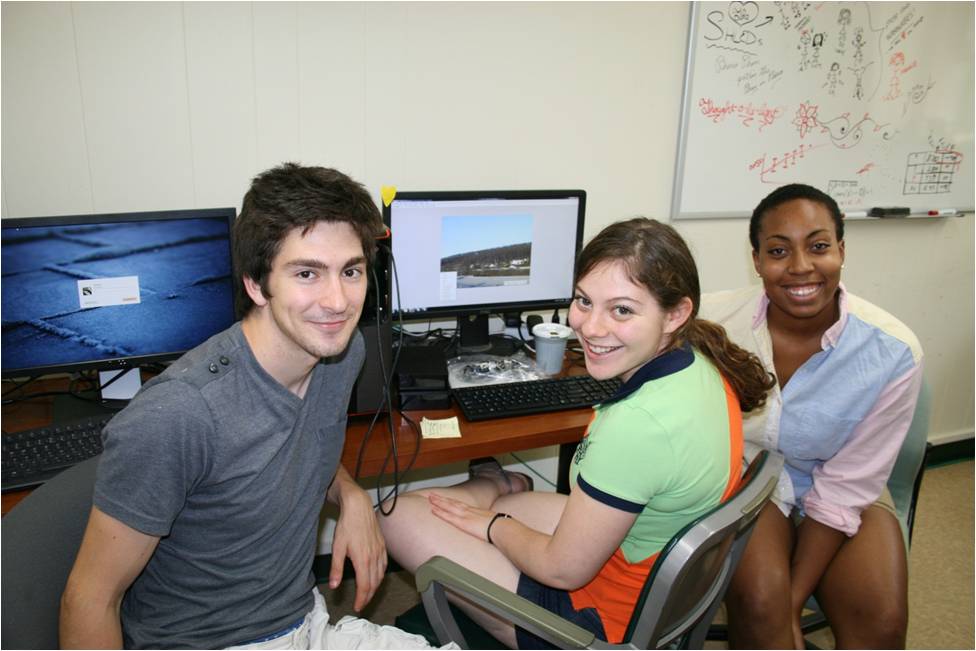You are here
Near remote sensing to track changes in phenology in forests, team Harvard
This year, the Richardson Lab of Harvard University and the Friedl lab of Boston University set out to study climate change using two different methods, remote sensing and near remote sensing. This summer, the two teams predominantly focused on honing the methods already established by other scientists to study the changing climate as well as widen the subset of biomes and localities studied.
 Team Harvard is comprised of Dmitri Ilushin of Harvard University; Sascha Perry, Lincoln University in Missouri; and Hannah Skolnik of Columbia University. We are under the direction of the Richardson Lab within the Department of Organismic & Evolutionary Biology at Harvard University. Phenology is the study of life cycles in various organisms. Specifically, we’ve been looking at tree phenology, tracking spring leaf out (when the trees start growing leaves after lying dormant all winter) and autumn senescence (when the leaves begin to change colors and drop from the trees). This summer, we have had the opportunity to challenge the question “Can webcam imagery track phenological changes?” Believe it or not, we can do just that! By looking at over 1800 different webcams with about 60 million images from all over the world, we were able to track the cameras' stability and views of vegetation. With this information, we’ve been able to track Green Chromatic Coordinate (GCC), a measure of the percentage of greenness of an area of an image. The GCC graphs yield quantitative information to track the changes of the seasons.
Team Harvard is comprised of Dmitri Ilushin of Harvard University; Sascha Perry, Lincoln University in Missouri; and Hannah Skolnik of Columbia University. We are under the direction of the Richardson Lab within the Department of Organismic & Evolutionary Biology at Harvard University. Phenology is the study of life cycles in various organisms. Specifically, we’ve been looking at tree phenology, tracking spring leaf out (when the trees start growing leaves after lying dormant all winter) and autumn senescence (when the leaves begin to change colors and drop from the trees). This summer, we have had the opportunity to challenge the question “Can webcam imagery track phenological changes?” Believe it or not, we can do just that! By looking at over 1800 different webcams with about 60 million images from all over the world, we were able to track the cameras' stability and views of vegetation. With this information, we’ve been able to track Green Chromatic Coordinate (GCC), a measure of the percentage of greenness of an area of an image. The GCC graphs yield quantitative information to track the changes of the seasons.
Below is a map of all the sites that are on the AMOS archive.
In order to parse through such a large data set, we had to come up with a protocol. Firstly, we conducted a preliminary, visual inspection of the 1879 sites with known locations. We looked through a subset of a site's images and noted FOV (field of view) shifts, when the camera moved noticeably. Based on the number of FOV shifts, we marked the sites either as stable (no movement), constant (consistently changing), or poor (too many shifts to use the site). Of the stable locations, we looked through each photo and found the exact times when FOV shifts occurred. We then made ROIs (Regions Of Interest), or selections of certain pixels of the image, that covered trees, shrubs, grass, or crops. Finally, a program was run that takes all of this information, calculates the GCC from the ROIs we made, and makes a time series (GCC graph) for each year. We decided to focus on creating GCC graphs for a vertical gradient along the Atlantic coast of the United States as well as two horizontal gradients in the US, one in the north, and one in the south.
The ROIs made for this field of view:
Studying phenology has been a blast. We’ve been able to study the immediate effects of recent climate phenomena. By calculating Green Chromatic Coordinate (GCC) curves and studying them across the United States, we have been able to see how these warming patterns have been affecting growing seasons across the country. What we have been doing has been on a smaller scale than satellite imagery so we can compare patterns even between species. However, by using the Archive of Many Outdoor Scenes (AMOS), we have huge spatial coverage, which allows us to compare how a certain species of tree is growing on the east coast versus the west coast, for example. Thus, webcam imagery represents a happy medium of scale. We can study the small scale and compare it to almost all other biomes and the same biome in different parts of the world.
We got to see some incredible places including the North Pole, Kenya and Japan in addition to the Continental United States. Here is ![[A representative photo from Kenya of a water buffalo at a watering hole.]](/sites/default/files/REU_Phenology6_2013.jpg) , one of our more interesting sites:
, one of our more interesting sites:

![[Great sites are green. Good Sites are yellow. Unusable sites are red. ]](/sites/default/files/REU_Phenology2_2013.jpg)
![[A sample vegetated site.]](/sites/default/files/REU_Phenology3_2013.jpg)
![[The ROIs made for this field of view.]](/sites/default/files/REU_Phenology4_2013.jpg)
![[The resulting GCC graph calculated for one year.]](/sites/default/files/REU_Phenology5_2013.jpg)
